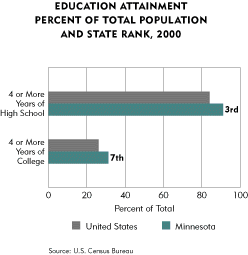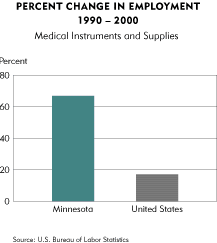What role should the University of Minnesota play to ensure that the state's economy does not falter and that the state maintains its economic vitality? This was one of the key questions that motivated the university's economic summit on the future of the state's economy in September 2000, a forerunner to this year's conference.
Many of the conference attendees were concerned the state's economy was beginning to falter. Some argued that Minnesota's economy was already falling behind the rest of the nation in developing high-tech companies. They noted the increasing number of corporate headquarters that had left Minnesota in recent years. And they pointed to a precipitous decline in venture capital funding going to Minnesota companies. Others, however, were not convinced that prospects were as bad as asserted, questioning the accuracy and relevancy of the data presented. A recent study by the University of Minnesota's Humphrey Institute of Public Affairs suggests that fears of falling behind have indeed been exaggerated. It showed that Minneapolis-St. Paul ranks ninth in the nation among U.S. cities in high-tech employment.
Nevertheless, most agreed the university should take a more direct and active role in promoting economic development and productivity in the state. They argued for an explicit partnership between the university and the local business community, with the objective of turning out more commercially oriented research, research that would result in more marketable products, more new businesses and more high-paying jobs. While this line of reasoning at first appears measured and persuasive, a closer examination raises doubts about the net benefits from such a partnership. Indeed, we think the recommendations that follow from this point of view can compromise the long-run vitality of the state's economy.

That vitality depends on a university that produces basic research and well-educated students. Because these products are types of public goods, unfettered markets will fail to produce enough of them. Public universities are designed to correct this market failure by providing more education and basic research than the market would yield on its own; these are the fundamental roles of a university and the argument for government support.
In general, evidence suggests that the spillovers to local economies from these public goods are substantial. And in particular, the evidence on the University of Minnesota's impact on this state's economy is impressive. For example, many argue that Minnesota's medical technology industry, which employed 20,400 workers in 2000, would not exist without the people and the basic research coming out of the university. Because of the university and the other higher-education schools in our state, Minnesota has one of the most educated workforces in the country. Encouraging the university to do commercially oriented research, therefore, can be costly in terms of the resources that are diverted from its fundamental mission.
Moreover, not only are the costs high, but the benefits of having the university pursue commercially oriented research are likely to be small, if not illusory. Government attempts to promote commercially oriented research, either directly or through universities, have yielded mixed results. And a comprehensive look at these efforts reveals a disturbing outcome: Government-sponsored research appears to simply substitute for privately sponsored research. In other words, the government's attempt to increase commercially oriented research—even if it is commercially successful—may fail because it drives out research that would have otherwise come from the private sector.
We do not mean to suggest that the university cut its links with the private sector and rest in an ivory tower. Rather, we suggest that policymakers carefully weigh the costs and benefits of policies that give the university a more direct role in promoting the state's economy. Some policies require few resources relative to benefits, such as providing channels for communication between university researchers and the private sector. Even some incubator programs that transfer university expertise to start-up companies may not require substantial resources. When the university sets out to conduct commercially oriented research, however, the costs are high and the benefits are suspect.

The road to a strong Minnesota economy is to keep the university producing what the private sector will not produce enough of—education and basic research. To that end, we should judge the university not by the number of patents it produces, but by the quality of the scholarly journal articles its faculty publishes and the quality of the students it graduates.
Complete paper text available in HTML format, with
charts in PDF format.
The University of Minnesota as a Public Good
[HTML]
The University of Minnesota as a Public
Good [41 KB PDF]






